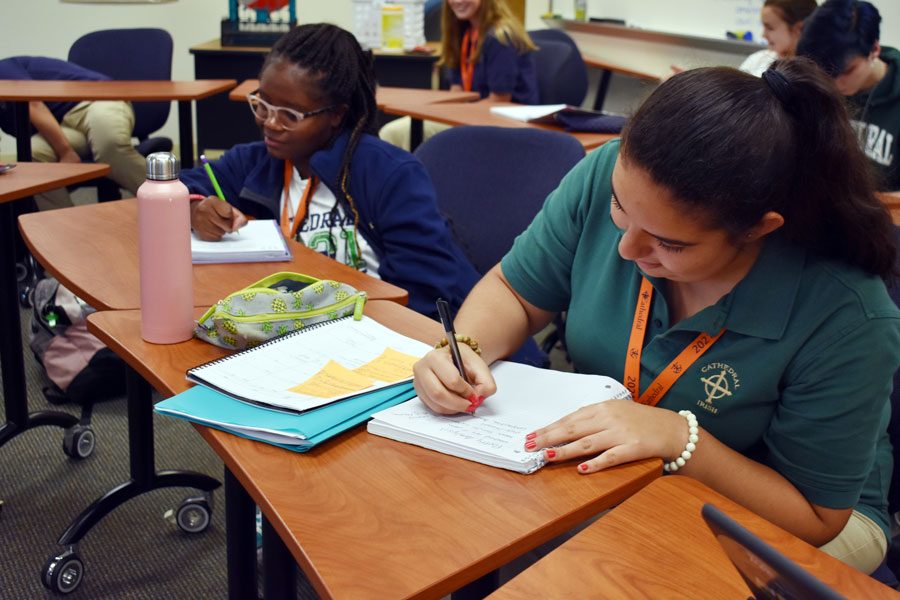Latin Student Union member, teacher react to tragedy
Arce-Rameriz, Panzer call for dialogue and respect
Ana Arce-Rameriz, right, takes notes during her E period English class in Loretto Hall.
Approximately one month after the massacre in El Paso, Texas that resulted in 22 people being shot to death and dozens more being wounded, many people across the country are still reeling at the effects of such a traumatic event, with another mass shooting in Texas over Labor Day weekend following a similar incident in Dayton, Ohio.
In the hours and days following the shooting, when it became apparent that the suspect had specifically targeted Latinos, the tragedy quickly began to symbolize a deeper issue. Junior Ana Cristina Arce-Ramirez, a member of the Latino Student Union, recalled the day that she first heard the news. “I remember thinking to myself, ‘When will it stop? I really thought our country was past this dark era of shootings,’” she said. “It was a topic brought up at my house during dinner, and that was when I was informed that the shooter had targeted Mexicans, or at least people who appeared to be so.”
Today, more than 18 percent of the United States population is made up of Hispanic or Latino descent, an increase from roughly 6 percent in 1980. Millions more can attest to the positive impact that this growth of the Latino presence in America has had.
One such person is English teacher Mr. Matt Panzer, who grew up in an Hispanic town. “My mother is Hispanic, born and raised in Cuba, and my father is traditional German-Irish,” said Panzer. “I grew up in Miami and moved to East Los Angeles where I taught for a number of years, which is a predominately Mexican-American area.”
Panzer, who serves as the faculty moderator of the Latino Student Union, is knowledgeable about the history of the city of El Paso. Situated in southern Texas on the Mexican-American border, it has traditionally been a place rich with cultural exchange and diversity. “It is certainly awful when there is specific targeting of a group, and it hurts the heart specifically because of what El Paso has meant to Texas, Americans and Mexicans,” said Panzer. “For years it had open borders and there was a sense of community between all of the cultures that lived there together.”
Here, some 1,200 miles away from El Paso, the effects of the shooting are prevalent. “It hurts me more when I think of the amount of hurt and damage people are going through due to the stigma and prejudice towards immigrants, specifically Mexicans nowadays,” Arce-Ramirez said.
For her, Panzer and others in the Indianapolis and Cathedral communities that have meaningful ties to the Latino population in this country, the shooting simply strengthens their conviction that something must be done to combat any signs of hatred toward any group of people.
Both Arce-Ramirez and Panzer agreed that conversation, dialogue and respect are the keys to helping the Cathedral family.
“I think the community could really use three things right now,” Arce-Ramirez said: “Comfort from others to let them know they are with us, prayers for the people who feel scared, and for people to take up the responsibility of educating themselves and others as to what is going on in today’s world so they can provide assistance to those in need.”
For Panzer, while he praises the school for “how much we have done with social justice and outreach,” he acknowledges that no one should ever stop trying to solve a problem. For him, making the issues at hand personal is a big step in the right direction. He said, “When we actually engage in dialogue, we demystify some of the stereotypes, and people stop being numbers and start being people.
“Once you get a sense of a person, you tend to sympathize with them. If all we ever knew was statistics and perceptions, we wouldn’t know much about each other. It is every individual’s responsibility on every side to try and break these mental patterns.”

Jackson Hern is a senior and a reporter for the Megaphone. At school he plays varsity soccer and is in Math League. Hern is a Student Ambassador, a member...

Gracie Carr is a senior and a photographer for newspaper and yearbook. She is a member of Student Council, Riley Dance Marathon, National Honor Society...







